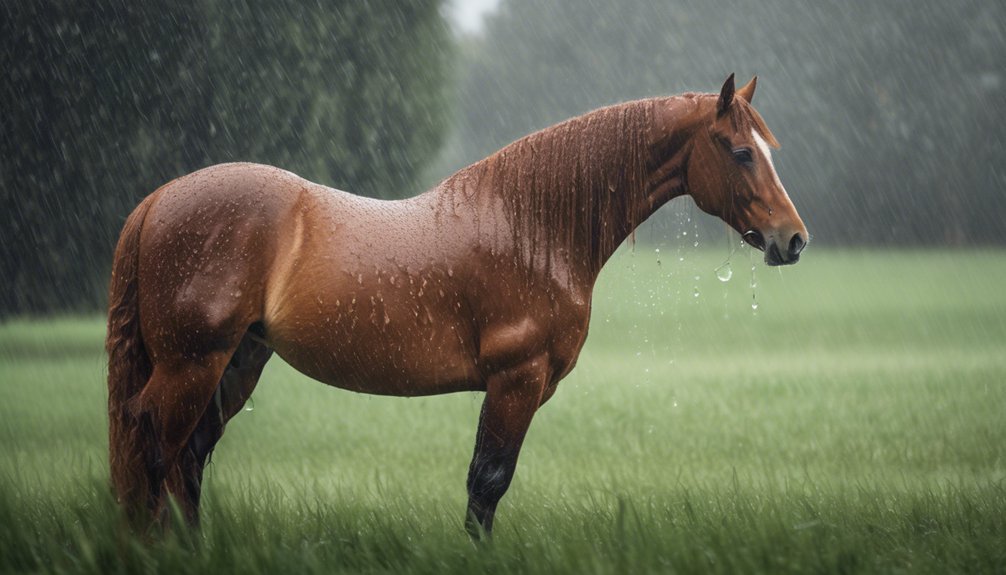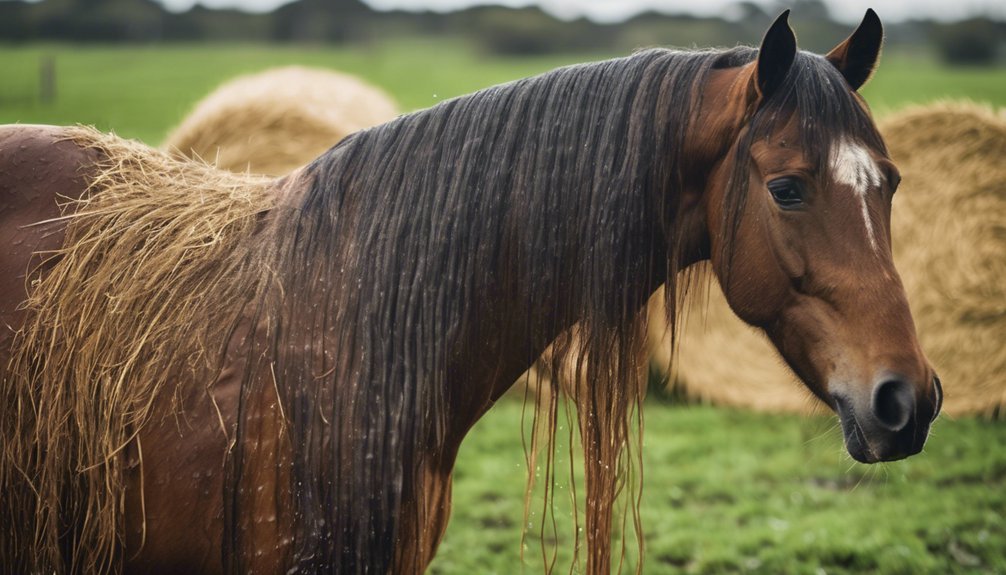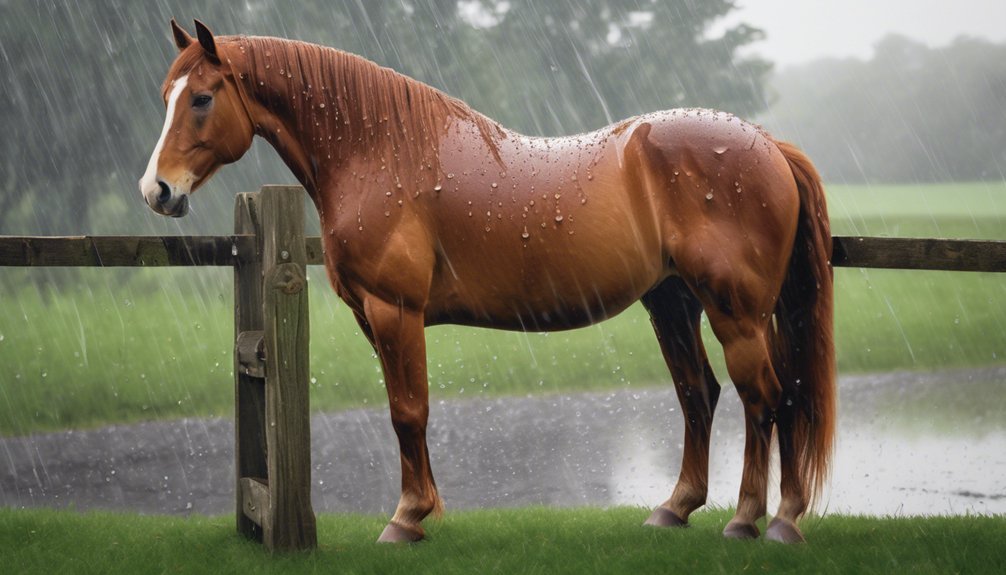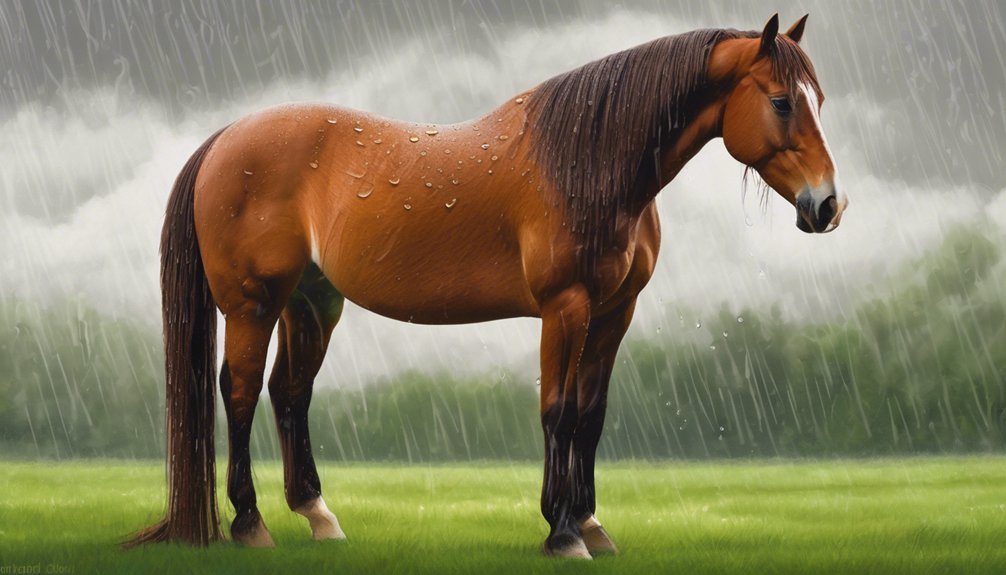
Maintaining your horse's coat during rainy seasons is crucial for their overall health. Prolonged exposure to moisture can lead to skin issues, so it's important to provide proper shelter and grooming. Regularly brushing helps promote skin health, but you'll also need to consider bedding and nutrition. Understanding these aspects can make a significant difference. Let's explore effective strategies to keep your horse's coat healthy and vibrant through the wet months.
Key Takeaways
- Provide a dry shelter for horses to escape rain and prevent skin issues caused by excess moisture.
- Use waterproof blankets to protect the coat from rain and maintain warmth during wet conditions.
- Regularly groom the horse to remove dirt, debris, and moisture, promoting skin health and circulation.
- Choose bedding materials that absorb moisture and keep the environment dry to minimize skin irritations.
- Monitor for early signs of skin issues, such as redness or excessive scratching, and consult a veterinarian if needed.
Understanding the Impact of Rain on Your Horse's Coat

While rain can be refreshing for your horse, it can also pose challenges for their coat if not managed properly. Excess coat moisture from prolonged exposure can lead to skin issues, such as fungal infections or irritation.
To provide adequate coat protection, ensure your horse has a dry shelter where they can escape the rain. Consider using a waterproof blanket when necessary, as it helps shield their coat from excess moisture while keeping them warm.
After a rainy day, check their coat for any signs of mud or debris, which can also cause skin problems if left unattended. By paying attention to coat moisture and providing proper protection, you'll help maintain your horse's coat health and shine through the rainy season.
Regular Grooming Practices
Regular grooming practices are essential for keeping your horse's coat healthy and vibrant, as they not only remove dirt and debris but also promote circulation and skin health.
By incorporating effective grooming tools and brushing techniques, you enhance your bond with your horse while ensuring its comfort.
- Currying: Start with a curry comb to loosen dirt and debris, using circular motions across your horse's body.
- Sweeping: Follow up with a stiff-bristled brush to sweep away the loosened dust, focusing on the neck, back, and hindquarters.
- Finishing Touches: Use a soft brush for the face and sensitive areas, ensuring a gentle touch and leaving your horse's coat shiny.
With these practices, you'll keep your horse looking its best, even in rainy weather.
Choosing the Right Bedding

Choosing the right bedding for your horse's stall is crucial for its comfort and overall health. Opt for bedding materials that provide excellent moisture control, like straw, wood shavings, or pelleted bedding. These options not only absorb excess moisture but also help reduce odors, creating a healthier environment.
Consider your horse's individual needs; for example, a horse with respiratory issues may benefit from dust-free bedding.
Regularly check and replace wet bedding to maintain a dry and cozy space. This not only enhances your horse's well-being but also supports its coat health by minimizing skin irritations caused by dampness.
With the right bedding, you'll ensure your horse feels secure and comfortable, even during the rainy season.
Proper Nutrition for a Healthy Coat
After ensuring your horse has a comfortable living space, it's time to focus on its nutrition, which plays a vital role in maintaining a healthy coat.
To achieve a beautiful, shiny coat, you need to ensure a proper nutrient balance. Here are three key elements to consider:
- High-quality forage: Opt for nutrient-rich hay or pasture that provides essential vitamins and minerals.
- Balanced grain: Choose a grain formulated for horses that meets their dietary needs and supports coat health.
- Coat supplements: Incorporate omega fatty acids or biotin supplements that promote skin hydration and enhance coat shine.
Utilizing Rain Sheets and Blankets

When rain clouds gather and the weather turns wet, utilizing rain sheets and blankets becomes essential for keeping your horse comfortable and protecting its coat.
Rain sheets offer numerous benefits, including waterproof protection and breathability, allowing moisture to escape while keeping your horse dry.
When choosing a blanket, ensure it fits well; a proper fit prevents chafing and allows freedom of movement. Look for adjustable straps and consider the blanket's length and width to match your horse's build.
Remember to check for signs of rubbing or discomfort regularly.
Bathing Techniques During Wet Weather
Although wet weather might seem like an inconvenient time for bathing your horse, it can actually be a great opportunity to keep its coat clean and healthy.
Here are some effective cold water techniques to consider:
- Use a gentle sponge: Dampen it with cold water and wipe your horse down, focusing on areas that accumulate dirt.
- Rinse thoroughly: If you decide to use shampoo, make sure to rinse it out completely to avoid skin irritation.
- Implement drying methods: After bathing, use a fleece cooler or a towel to absorb excess moisture. This helps prevent chills and keeps your horse comfortable.
Managing Mud and Dirt

Since managing mud and dirt is essential for maintaining your horse's coat health, it's crucial to implement strategies that mitigate their impact. Start by creating designated dry areas in your paddock for your horse to stand and rest. Use good drainage and consider installing mats in high-traffic zones to reduce mud accumulation. Regular grooming helps in dirt prevention, as it removes debris and promotes a healthy coat.
| Strategy | Benefits | Tips |
|---|---|---|
| Designated Dry Areas | Reduces exposure | Place near feeding areas |
| Good Drainage | Prevents pooling | Regularly check for blockages |
| Regular Grooming | Enhances coat shine | Use a curry comb and soft brush |
Implement these methods to keep your horse's coat clean and healthy.
Recognizing Skin Issues and When to Seek Help
Recognizing skin issues early can make a significant difference in your horse's health and comfort, so it's important to stay vigilant.
Look for signs of skin irritation or fungal infections, as these can quickly escalate if left untreated. Here are three key indicators to watch for:
- Redness or Swelling: Any inflammation can indicate irritation or infection.
- Hair Loss: Patches of missing hair could signal fungal conditions or other skin issues.
- Excessive Scratching: If your horse is constantly rubbing against surfaces, it may be trying to relieve discomfort.
If you notice any of these symptoms, don't hesitate to consult your veterinarian.
Early intervention can prevent serious complications and ensure your horse remains healthy and comfortable during the rainy season.
Frequently Asked Questions
How Does Humidity Affect My Horse's Coat Condition?
Humidity affects your horse's coat condition by causing excess moisture that can lead to skin issues. Regular grooming and proper coat maintenance help prevent problems, keeping your horse comfortable and their coat healthy and shiny.
Can Different Coat Colors React Differently to Rainy Weather?
Different coat colors can indeed react differently to weather impact. Darker coats absorb more heat, while lighter shades reflect sunlight. Understanding these differences helps you care for your horse's coat effectively during changing weather conditions.
Are There Specific Supplements for Coat Health During Rain?
For coat health during rainy days, consider supplements rich in omega fatty acids and biotin. These coat conditioning nutrients from dietary sources promote shine and resilience, ensuring your horse's coat stays healthy and vibrant despite the weather.
How Often Should I Check for Skin Irritations?
You'll want to keep a watchful eye on your horse's skin health, checking for irritations at least once a week. Regular inspections help you catch issues early, ensuring your equine friend stays comfortable and happy.
What Are Signs of Stress From Rainy Weather in Horses?
You'll notice signs of stress in your horse through behavioral changes like restlessness or isolation, and physical symptoms such as sweating or loss of appetite. Staying attentive helps you support your horse during challenging weather.
Conclusion
By following these practices, you can keep your horse's coat looking as shiny as a new penny, even in the rainiest of seasons. Regular grooming, proper bedding, and the right nutrition are essential. Don't skimp on waterproof blankets to shield your horse from the elements, and stay vigilant for any skin issues. With your dedication and care, your horse will thrive, sporting a healthy, lustrous coat that turns heads, no matter the weather!





